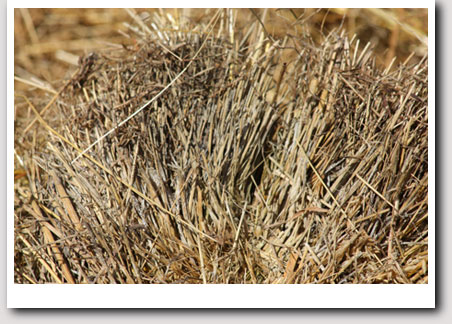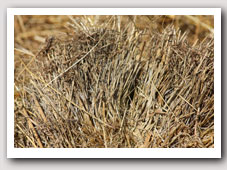Moulds & Mycotoxins
Field fungi or moulds inhabit soils, grass and crops. They are an important part of the ecology and therefore are not all bad!
However the more acidic the soil environment becomes the more pathogenic fungi will thrive and upset the delicate ecological balances and become a health threat to livestock. Hence the roadside risk indicators for farmers warning them about Sporodesmin, a fungal spore which causes facial eczema in livestock. Whilst it doesn’t cause the same disease in horses, it’s presence and levels are an indicator that conditions are ‘right’ for fungi in general to become a serious problem.
Moulds

Aspergillus on hay, a known asthma allergen.
The climate and the generally low pH of the soils, means conditions are frequently very favourable to the explosive proliferation of fungal spores and myco-toxins.
Particularly in tropical areas where moist, warm conditions are common.
Sometimes you see mushrooms in the field or mould growing on the horse manure, or black smut moulds on seed-heads in humid weather but most fungi are invisible to the naked eye.
If you happen to live anywhere near any orchards you will know how often they have to spray for fungi.
Pasture fertilised with traditional commercial fertilisers like superphosphate makes an ideal environment for them too.
Slashing grass and leaving it to rot on the ground also creates a suitable environment for fungi if there is any moisture at all.
An ‘endophyte’ fungus lives inside certain grasses especially Perrennial Rye-Grass and Tall Fescue.
‘Ergots’ look like mouse droppings dangling off seed-heads of some grasses like Paspalum
Storage moulds thrive when hay and grain are stored poorly, with too much moisture content.
So what are
Myco-toxins?
‘Myco’ is the Greek word for fungus so myco-toxins are ‘poisons or chemicals produced by fungi’.
Fungi or moulds produce myco-toxins when they are stressed by weather and moisture levels.
They are invisible and insidious. Some are prolific in humid or tropical conditions, others become a problem in Autumn and spring.
The presence of mould does not necessarily mean the presence of mycotoxins but the trouble is you have no way of knowing.
It is known there are at least 500 different moulds out there producing hundreds of different myco-toxins. Many more are yet to be isolated and identified.
In 1985, the World Health Organisation estimated that approximately 25% of the world's grains were contaminated by myco-toxins. This figure has most certainly grown since then due to an increase in global import and export of grains and cereals and the changing environmental and weather patterns.
Myco-toxins do not show up in blood tests
The Affected Horse
Your horse can become infected by ingestion with grass and contaminated feed or by inhalation whilst eating
(Go to ‘Pasture Heaves’)
Both need to be addressed.
Myco-toxins are known to suppress the immune system and affect normal functioning of major organs: the intestinal tract, liver, kidneys, reproductive system and the central nervous system.
Problems caused by myco-toxins are often vague, non-specific and difficult to identify. They do not respond to traditional veterinary treatment. They are not bacterial so will not respond to anti-biotics.
Some or all of the following may be exhibited:
- off their feed, loss of appetite
- increased susceptibility to viruses and disease
- failure to thrive, ill-thrift, no top-line
- failure to grow to potential
- intestinal problems, diarrhea
- lethargy
- vasoconstriction causes necrosis (death) of affected tissue leading to colic if it is part of the intestine or abortion if it is the uterus
- heat stress or disturbance to the body’s ability to regulate temperature
- unco-ordinated movement, staggers
- decreased conception rates
- increased incidence of abortion, still births
- increased length of gestation
- ‘Red Bag’ delivery, thick placentas
- weak suckling by the newborn foal
 Calm Healthy Horses
Calm Healthy Horses